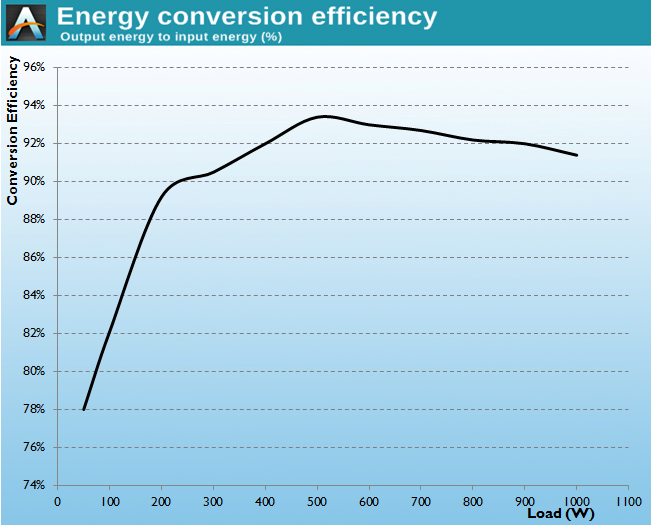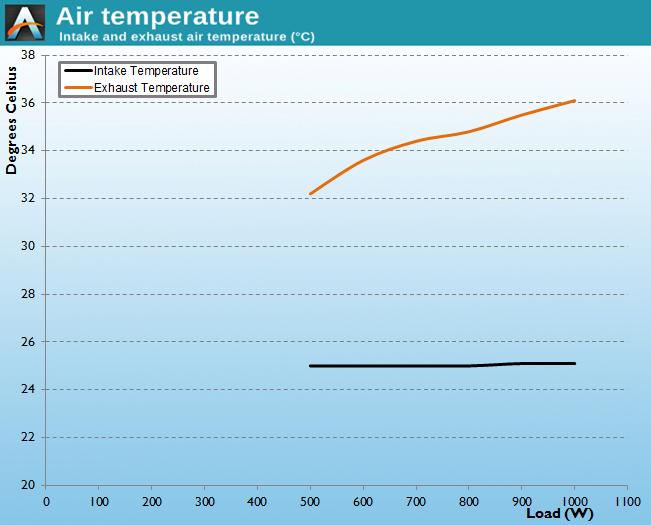Corsair RM1000 Power Supply Review
by E. Fylladitakis on April 24, 2014 6:00 AM EST- Posted in
- Cases/Cooling/PSUs
- Corsair
- PSUs
- RM Series
Cold Test Results
For the testing of PSUs, we are using high precision electronic loads with a maximum power draw of 2700W, a Rigol DS5042M 40MHz oscilloscope, an Extech 380803 power analyzer, two high precision UNI-T UT-325 digital thermometers, an Extech HD600 SPL meter, a self-designed hotbox, and various other bits and parts. For a thorough explanation of our testing methodology and more details on our equipment, please refer to our How We Test PSUs - 2014 article.
The Corsair RM1000 performs very well at room temperature, easily surpassing the 80Plus Gold Certification limits and reaching a maximum efficiency of 93.4% at 50% load. The average efficiency of the RM1000 within the nominal load range (20% to 100%) is 91.8%, which is an astonishing figure. When the load is reduced down to 50W, the efficiency drops down to 78%; however, although that may sound like a poor result, we should clarify that this actually is a very good figure and rarely can a PSU maintain an efficiency this high at just 5% load. However, such a low load is considered an "out of range" condition and does not affect the 80Plus certification, which takes into account only the 20% to 100% nominal capacity range.
There are no exhaust air temperature or noise measurements below 50% load because the fan does not spin until we reach 500W. The RM1000 is virtually inaudible while operating at room temperature, even when heavily stressed. Due to the passive cooling profile and the small heatsinks, however, the RM1000 tends to run warm, with the temperature of the tiny secondary side heatsinks floating around 55 °C and reaching up to 59.7 °C.















55 Comments
View All Comments
dirtyferret - Thursday, April 24, 2014 - link
too bad every professional reviewer disagrees with that opinionfrewster - Thursday, April 24, 2014 - link
Thanks for the good laugh. There seems to be an influx of people who believe that any PSU not made by Seasonic is trash, but that's BS.meacupla - Saturday, April 26, 2014 - link
The fan itself is a cheap sleeve bearing type.I don't understand why these companies opt for fans that can't be orientated horizontally without increased wear and noise. And the thing is, the price difference between a sleeve and double ball bearing fan is only about $1
benbenkr - Monday, May 12, 2014 - link
There's one issue these pro reviewers never seem to mention, coil whine. It doesn't inherently make a PSU bad, but boy it is annoying.I just replaced a RM650 due to the insane coil whine it has, even at low level loads.
The CWT made RM Corsair PSUs are quite solid, credit where it is due. But the coil whine is ridiculous. For that, I needed to change to a Seasonic KM3-based platform in the spirit of a Cooler Master (I know, a brand notorious for horrible PSUs) V700.
frewster - Thursday, April 24, 2014 - link
I don't think you know what you're talking about. Those ones made by Chicony? They're on par with Delta quality PSUs. And CWT? Hardly "horrible."YoloPascual - Saturday, April 26, 2014 - link
Yeah the server psu's that are made by Chicony are on par with Delta. The RM750 and RM850 are not. CWT made HX series are very good. CWT made RM series are mediocre at its finest. I does not need to be Seasonic/Super Flower made, but it should competent.just4U - Thursday, April 24, 2014 - link
I wish they'd use seasonic more.Voldenuit - Thursday, April 24, 2014 - link
I have a CWT ODM Corsair CXM-500 in my rig. My beef with it is that while it is pretty quiet at idle, running a GPU load (gaming, video benchmarks) on my GTX 760 will bring the fans up until it becomes the noisiest component in my system.Running a pure CPU load (undervolted i5 4670K) such as Prime95 does not elicit this behaviour, and I've controlled for other variables such as case, CPU and GPU fan speeds, so the threshold for "noisiness" from the PSU seems to be around 200-250W, which would correspond to a 40-50% load on the PSU.
It's not unbearable, and not worth returning or exchanging the unit, but it was a bit disappointing for me since I was trying to build as quiet a system as I could on my budget.
Voldenuit - Thursday, April 24, 2014 - link
PS It's worth noting that I don't have any sound measuring equipment, so I don't have any SPL measurements, and that my personal threshold for noise and my apartment noise floor might be very different from others'.I've seen posts both praising and condemning the same CX-500M (sorry, had the model number mixed up in OP), so YMMV.
lorribot - Thursday, April 24, 2014 - link
Does truly have a "chamfered edges and the rimmed bottom" as you state in the conclusion or should that be a ribbed bottom?